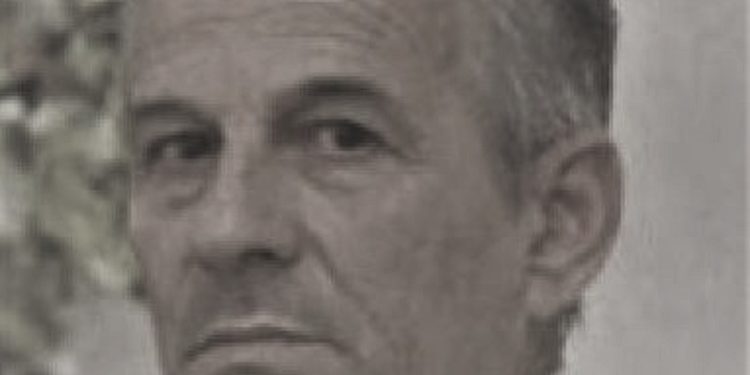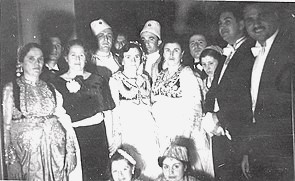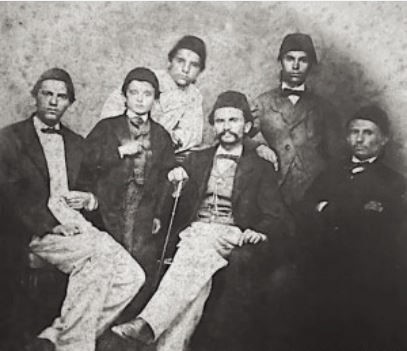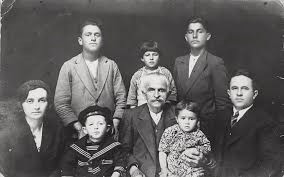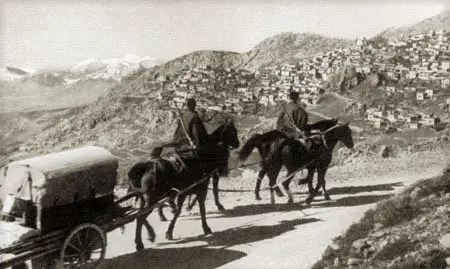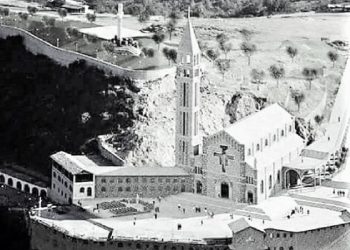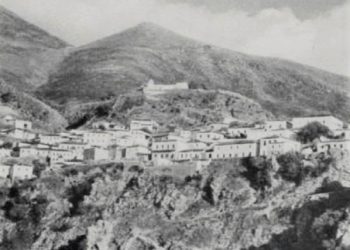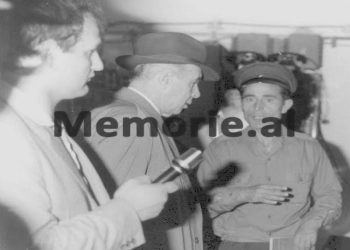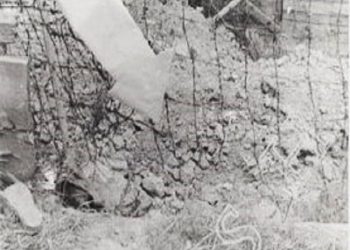From Vepror Hasani
Memorie.al / Hasani and Mehmet Deda, were the two great-grandfathers who created the big families of Frashër. Hasani came from the family of Kol Nikolë, while Mehmet Deda, from the family of Dede Duka, the latter coming from Duke Kryeziu. From Hasan, the great tribe of Sulejmanbellinje was created, who were friends of Ali Pasha Tepelena. From the Sulejmanbellinjes, the Hasanas of Butka, the Skënderas tribe and the Kasollare tribe of Frashëri are also descended, these last two, dedicated to Bektashism, while from Duke Kryeziu, and the great Vilak tribe was created. To understand more, follow the narration.
1431, Frashëri with 6 houses
Something is known about the ancestors of Frashëri. In the year 1431-’32, according to the ijmal (summary) register, of the Vilayet of Përmet and Korça, Frashëri had 6 houses, of which 5 were headed by the head of the family and one house was occupied by 1 bachelor. The families were Christian. (The register drawn up in Ottoman is kept in the Archive of the Prime Minister of Turkey (Basbankalik arsivi. Maliye’den mudevver def.no. 231. The photocopy of the defter of the year 1431-32, translated by Vexhi Buharaja, is in the archive of the Institute of History, Tirana, but unpublished until today.
In 1504, according to the mufasal (detailed) register, Frashëri had 41 houses, of which 40 were Christian and 1 family with Muslim members.(The original of this notebook is kept in Ankara (Tapu ve Kadastri umum mudur – lugumum Arsivi Ankara), a photocopy of this notebook is also in the archive of the Institute of History, Tirana. Both the original and the translations are still unpublished. (Kristo Frashëri , “Frashëri – His glory”, p. 24). Only 28 names of the heads of the family are published, which does not give us the opportunity to get to know all the families of this time that we have, we notice that the largest tribe is that of Duke Kryeziu.
The tribes of Frashëri in 1504
In the census of 1504, the names of the inhabitants of Frashër have this order: Dedë Duka, Dukë Kryeziu, Uk Deda, Gjon Deda, Martin Bardhi, Deskë Gjini, Dedë Gjini, Kozma Shurbi, Kolë Shurbi, Llazër Shurbi, Bendo Shurbi, Gjon Gjoni , Llazër Gjoni, Gjin Tole, Mihill Thoma, Dhimitër Deda, Ilia Leka, Dhimitër Nikolla, Lekë Kushta, Tole Mihali, Dede Dhimitri, Kolë Mihali, Thanas Kozma, Tole Kozma, Gjon Prifti, Nikola Mesera, Decke Tole, Mëhill Thano.(Taken from Alfred Frashëri and Neki Frashëri “Frashëri in the history of Albania”, p. 35).
The tribe that attracts attention again is Duke Kryeziu. If we take into account the fact that in this period the father’s name was used as a surname, we can make the following order of these families: Deda Duka, (Deda son of Duka); Uk Deda, Gjon Deda, Dhimitër Deda (sons of Deda) and Dede Dhimitri (son of Dhimitri). The names of the families belong to early Albanian Christianity, there is still no influence of Orthodox Christianity. (This register is also located in the Institute of History, Tirana, it has not yet been published).
The tribes of Frashëri in 1593
In the third census, mufasal, of the Sanjak of Vlora, in 1593, Frashëri has 58 houses, of which 50 are Christian. We now also notice names of Eastern (orthodox) Christianity. From the 1593 register, only 31 names have been published in this order: Stojo Deda, Laskë Deda, Thanas Deda, Martin Gjini, Gjike Gjoni, Kolë Gjoni, Likë Gjoni, Velko Gjoni, Laskë Tole, Kolë Nikolla, Martin Gjira, Gjike Mërtira , Gjike Kola, Kola Gjika, Like Kola, Pjeter Kola, Mërtir Kola, Likë Papa, Kola Papa, Todor Dhimo, Stepa Stiri, Duke Laska and Gjokë Doçi
(Taken from Alfred Frashëri and Neki Frashëri “Frashëri in the history of Albania”, p. 35).
Genesis of large families
In 1593, the tribe that prevails in Frashër is the tribe of Kol Nikolla with the families: Gjikë Kola, Kolë Gjika, Likë Kola, Pjetër Kola and Mërtir Kola. Part of this tribe is also the families: Likë Papa, Kolë Papa and the Gjike Gjoni, Kolë Gjoni, Likë Gjoni and Velko Gjoni families.
More specifically, the KOLA (NIKOLLA) tribe consists of the following families: Nga Gjikë Kola and Kol Gjika (his son); from Likë Kola, Pjetër Kola and Mërtir Kola (sons of Kola); from Gjikë Gjoni, Kolë Gjoni, Likë Gjoni and Velko Gjoni (sons of Gjoni); and from Likë Papa and Kol Papa (sons of the Pope). The names that are repeated within the tribe and that serve as surnames are five: Gjike, Like, Kola, Papa and John, who are their grandfathers. Also, the tribe of Duke Kryeziu continues to be present in 1593, with the families: Stojo Deda, Laskë Deda and Thanas Deda. In this period we also notice the names of Eastern (orthodox) Christianity. So, the NIKOLLA tribe and the DEDA tribe are the two largest tribes of Frashër, while the Aliçka tribe, or of Sali Butka, has its own history, which appeared for the first time in 1650, or 220 years later, from the first population census in 1431-1432.
The first 8 Muslim families
In the census of 1593, 8 Muslim families appeared for the first time. One of them was Islamized before the census of 1504, that is, the Islamization of the inhabitants of Frashri began almost a century ago. According to all possibilities, but also according to the elders of Butka, the first of this first Muslim family was called Hasan. The heads of Muslim families are given in this order:
Hasan Papa,
Mehmet Deda,
Yusuf Nikola,
Sulejman Yusufi,
Hasan Gjika,
Hasan Andrea,
Jakup Kasemi
and Skender Hasan.
Three of the above families: Sulejman Jusufi, Jakup Kasemi and Skënder Hasani were the first to change their religion, because their surnames are also Islamicized, while the other 5 were converted later because they still carry Christian surnames: Hasan Papa , Jusuf Nikolla, Hasan Gjika and Hasan Andrea, but originally all these families derive from HASANI, who came from NIKOLLAT, from them the great tribe of SULEJMANBELLINJA, KASOLLARI and SKENDERAI, while from MEHMET DEDA, who came from Duke Kryeziu or from his successor Duke Deda, the great tribe of VILAK was created. We will see how true this is.
Sulejmanbelli – descendants of Nicholas
From all the tribes of Frashëri, only two tribes attract attention: NIKOLLA and DEDA. The NIKOLLA tribe appears in 1593 with the surnames Gjike, Like, Kola, Papa and Gjoni; they are the grandparents of the families of this tribe. Based on the 8 Muslimized families, it follows that: JUSUF NIKOLLA is a descendant of the Kol Nikolla family. SULEJMAN JUSUFI derives from Yusuf Nikola, the possibility that Sulejman Yusufi comes from another tribe (not from Nikolas) does not exist. Even the registrars of 1593 put the names Jusuf Nikolla and Sulejman Jusufi one after the other, because the registration also aims to identify the tribes. Sulejman Jusufi comes from the tribe of Likë Kola, Pjetër Kola and Mërtir Kola (sons of Kola); so, Sulejman Yusufi is the great-grandfather of SULEJMANBELLINJA.
SKENDER HASANI, his possible origin is the Hasan Papa family. The surname “Papa” tells us that the people of this family may have performed religious duties even before, so they devoted themselves to Bektashism, because it was closer to Christianity and aimed at religious coexistence. Skënder Hasani is the great-grandfather of the SKENDERA tribe. Skenderas, devoted himself to the Bektashi faith.
JAKUP KASEMI, just like Skender Hasani, Jakupi also originates from the Papa family; one of them from Likë Papa, the other from Kol Papa. (Likë Papa and Kole Papa were brothers). Jakup Kasemi is the great-grandfather of KASOLLARI. Even the Kasollars dedicated themselves to the Bektashi faith.
HASAN GJIKA, is a descendant of the Gjikë Kola and Kol Gjika families (sons), have their own families. The Kola families are part of the tribe from which Jusuf Nikolla and Sulejman Jusufi came from. As a result, this family is united with the tribe of Sulejmanbellinje. Even the Kasollars and Skenderas (descended from Likë Papa and Kola Papa) are part of the Suleimanbelli, but more separated from the Suleimanbelli because they devoted themselves to God and not wealth.
HASAN ANDREA appears among the first eight Muslims of Frashër. We remind you that the registration lists of Frashëri’s families have not been published in full. In the list of 1504, 13 families are missing, while in the list of 1593, 27 families are missing. Although the register has been translated and is located in the Archive of the Tirana History Institute, it has not been published to date. But Hasan Andrea, like the other Hasans, has the same origin – that of NIKOLLAVE. His grandfather is HASAN. This is the reason that makes us believe that Frashëri had a Hasan the Great, from whom there were many heirs, with whom even the Sultan was interested in having an agreement with them.
In the KOLA (NIKOLLA) tribe there is also a person with the Christian name VELKO. We find Velko in the Gjoni families: Gjikë Gjoni, Kolë Gjoni, Likë Gjoni and Velko Gjoni (son of Gjoni), part of the origin of the Sulejmanbellinjes. We know that a family with the head of the family named VELI broke away from Sulejmanbelli and created the VELIBELLAR tribe. Could this have been the Velko family, which, in order not to forget its grandfather, named one of its descendants VELI, as a sign of respect for Velko? We cannot say this for sure, but it is known that the Velibelars were part of the Sulejmanbellin family
The families that have their roots in Hasan
We thought so, because we noticed that each of the Nikola families has its own Islamized representative: Kol Nikola has Hasan Nikola; Gjike Kola and Kol Gjika have Hasan Gjika; Kol Papa and Lik Papa have Hasan Papa, while the Gjikë Gjoni, Kolë Gjoni, Likë Gjoni and Velko Gjon families do not have one, even though they belong to the great Nicholas tribe, which seems unbelievable. However, in terms of importance, this assumption does not play any role, it can only serve someone who has such a fact.(Also the document of 1593, translated by Prof. Selami Pulaha, is in the archive of the Institute of History, Tirana).But it is also a fact that Hasan Andrea (for whom there is no other information), must be another grandson of Hasan, son of Andrea.
Four people named Hasan
We are returning once again to the three recordings made in Frashër. According to the ijmal (summary) register of the year 1431-’32, Frashëri had 6 houses (5 houses with the head of the family and 1 house with 1 bachelor). As you can see, the village was small, only the single person attracts attention. He may be young, he may be an adult, and we don’t know anything about him, except for the fact that he is unmarried and has no family, because he does not appear as the head of the family. In all probability, he was the first person to embrace the Muslim faith, and perhaps that is the reason why he remained alone.
Be the first to betray the trust of your ancestors, no one follows you. As a reward you have only neglect and loneliness. Probabilities show that it may have happened like this; even the elders of Butka claimed that his name was Hasan. In 1504, in the second mufasal (detailed) census, when 74 years had passed since the first census of 1431-1432, we see that Frashëri has 41 houses, of which 40 are Christian and only one house with members Muslims. The people of this Muslim family may be the descendants of the single person.
Why is the name “Hasan” preferred?
In the third (mufasal) census of 1593, when 89 years had passed since the second census, the number of houses in Frashër went from 41 to 58; of which 50 were Christian and 8 from Muslim families: Hasan Papa, Hasan Gjika, Hasan Andrea, Skënder Hasani, Jakup Kasëmi, Jusuf Nikolla, Sulejman Jusufi and Mehmed Deda.The question that arises is: Why so many people with the name Hasan?! The village has only 58 houses, more or less they belong to the same tribe, since the origin starts from 5 families, then why do so many run after the name Hasan?! The answer is this: the man who was once shunned by his family is no longer alive, but now his nephews are following his example.
The grandson revives the name of the great-grandfather Hasan
So; since the last census (1504-1593), 89 years have passed and the Muslim religion has begun to be accepted. The grandchild wants the resurrection and resurrection of its grandfather. This shows that, in addition to being a good, honest and brave man, so much so that he had the courage to agree to live alone, he was also rich, favored by the government authorities of the time, also due to the fact that he joined the first to believe in Islam, even though he was single, he had a house, when it is known that even in those times building a house was expensive.
His descendants are now the legal heirs of their grandfather’s property. Therefore, the name Hasan is desirable and liked by relatives, his name continues to be present in 4 Islamized families out of 8 in total. Until today, a lot has been written about Frashër and the history of Frashër, even by people who have had in-depth knowledge of Frashër, but in no case have the Hasans and Sulejmanbellis been mentioned. It happened like this, that the HASANAS tribe, of Butka, was kept in oblivion, which have as their great-grandfather, the great Hasan of Frashër.
The Vilak tribe
If we return to the census of 1593, we notice that the old names of the Deda tribe: Dede Duka, Uk Deda and Gjon Deda, no longer appear, perhaps because they were Islamized. From the old ones we find 2 families: Duke Laska and Laskë Deda. Part of this tribe is also 2 new families: Stojo Deda and Thanas Deda. The tribe originates from Duke Kryeziu, mentioned in the second census of 1504, who must have been a Duke. This high title of aristocracy was held by the ruler of a duchy (province), where he was the owner of property.”… At least until the third quarter of the 15th century, at the head of the timar of which Frashëri was also a part, there were Christian Spahians… It is known from the history of the Ottoman Empire that until the beginning of the 16th century, the appointment of Christian Spahians at the head of the timars , was at least for the Albanian years, a common phenomenon”.(Kristo Frashëri, “Frashëri – His brilliance and ruin”, p. 23).
Dedat, large property owners
The Dedas must have been early owners of property in Dangelli or outside it. The first Islamized person of this tribe is Mehmet Deda, who is often mentioned by name. The Vilaks were born from him. They built their houses under the rock of Golik and not on the slope of Kokojka where the other beylers settled. Why it happened like this is understandable: in the beginning, Frashër was only called the village on the slope of Kokojka Mountain; there were 6 houses, while the opposite village on the slope of the Golik rock was called Vilja (or Villa); there were 12 houses. Afterwards, the two villages together were called Frashër. The Vilaks built their houses on Shkëmbi e Golik, because they were residents of Vilja, they had their grandparents’ property there.
This is also the reason why Mehmet Frashëri, the son of Mustafa Pashë Frashëri, after the burning of Voskopojë, took several Vlach families to Vilja, because Vilja or Vila was their place of residence. In this tribe, the name “Mehmet” is repeated from one generation to the next, because the first of them was Mehmet Deda.From this tribe, a number of important names are mentioned: Mehmet pashë Frashëri, his son, Shemsedin bey Frashëri, spahi in the province of Opar and a resident of Opar, who had the opportunity to meet with the English consul, William Martin Lik, during his travels that the latter had in the fall of 1805, in the Albanian years.
While the other son of Mehmet Pashë Frashëri, Çeçiz Frashëri, during the first part of the 19th century, was the myteselim of Opar and the zab of Voskopojë, which even though he lost them for a period of time, he regained them. Adem Pasha, vizier (prime minister) of the Ottoman Empire during the 18th century also belongs to this tribe. Then, when Mehmet Frashëri, (son of Mustafa Pashë Frashëri) had received the title of pashë, in 1772 he bought Shpicka and Nikolica in Kolonje and Voskopoje, thus becoming their general spahi. As a well-known name of this tribe, we are also mentioning Tefik Vila, the father of Nuri Vila, who had the biggest houses on the slope of Golik.
The Hassans of Sulejmanbellinje
The Sulejmanbelli built their houses at the top of the Kokojka slope, while the other Beylers settled below them. The Frashëri brothers (Abdyli, Naimi and Sami Frashëri) also had their houses on this slope, with which they had permanent friendship. Even with Ali Pasha Tepelena, they were friends, but there were periods when they went against each other, because Tepelena Pasha could not lower his head. However, the bravery of Sulejmanbelli did not lose its luster in any case, but preferred to live with dignity.
The Hasanas of Butka, great-grandsons of the great Hasan of Frashër
The tribe of HASANA arrived in Butka after the fall of the pashallak of Ioannina. Even the first of this tribe was called Hasan, a descendant of Sulejmnabellinje. And not only that: Ahmet Hasanas, the son of Hasan, married to Arziko, the daughter of the tribe of Teki and Bexhet Selenica, a well-known beyler of Selenica i Frashëri, named one of his sons Ali, because Ali had also been a descendant of Sulejmanbellinjve, while Tefik Hasanas, Hasan’s grandson, married to a daughter of the beylers of Poloska, Merimena, named one of his sons Sulejman because they were aware that they came from Sulejmanbellinj; likewise, Qerim Hasanas, grandson of Hasan, married to one of the daughters of the Malukas (the most powerful of Kolonja), named his first child Veli, because as is known, a family named Veli was separated from the Sulejmanbellians from which the Velibelars were created.
The name “Hasan” exclusive to Sulejmanbellinje
The name Hasan was exclusive to Sulejmanbelli. From the beginning, Sulejmanbelli had 4 Hasans: Skender Hasani, Hasan Gjika, Hasan Papa and Hasan Andrea.If another tribe would baptize one of its children with the name Hasan, it would be like “robbing”, even when the village had 58 houses, no one would think of taking the name of another tribe. The name “Hasan” belongs to the Sulejmanbellians, the Velibelars, the Kasollars, and the Skenderas, who also had a relationship with Ajaz bey (the ancestor of the Frashëri brothers). The Hasanas of Butka continued to make krushqi with well-known beylers.
Fetiu, the grandson of Hasan of Butka, married Rakibe from Vilat e Zboqi (a branch of Villas of Frashër), while the daughter of Rakibe’s uncle, married to the bejlers Alizoti of Mileci, whose descent came from Murat, a relative of Ahmet The bird, coming from Mati. Hasan’s two great-grandsons, Qani and Gazi Hasanas, married the daughters of the Alizots of Mileci, while their other two brothers: Erfan Hasanas, married the daughter of the famous beylers of the Koçibells of Qatrom, while Fuat Hasanas, the daughter of a well-known family from Pesari i Black. From this tribe, as we have said, both the Skenderas and the Kasollars came.
Who were the Frashërlli who settled in Butka
“The first to come from the tribe of Alicka of Frashëri, in Butka, was Saliu’s grandfather, named Elmaz Zaimi. This grandfather of Sali brought with him his brother Orhan and the two cousins Belul and Hasan”, – this is how Hysen Butka, a relative of Sali Butka, writes on the first page of his book of memories “Sali Butka in my memories” , – but the truth is that Hasan belonged to the Sulejmanbellin tribe and not to the Aliçka tribe. Perhaps Beluli was also Sulejmanbelli, but the people of Beluli themselves, to which tribe they belong, must say this. For the Hasanas tribe, everything is clear. Memore.al





